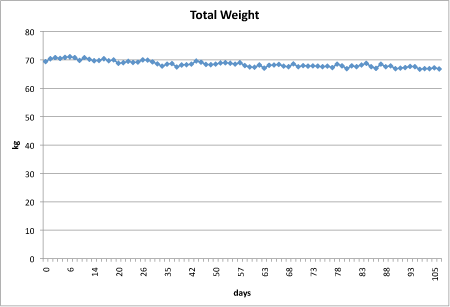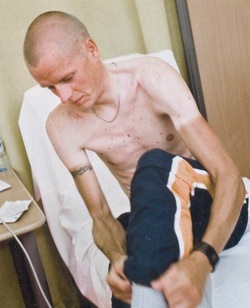
|
I spent the Fall semester preparing for the Tucson marathon in December (exercise) and actively trying to lose weight (dieting).
The general claim is that:
In general, for every 1 percent loss of body mass, primarily as body fat, there will be an approximate 1 percent increase in running speed.[Ignoring resting oxygen consumption, the energy cost of horizontal running is 0.2 milliliter of oxygen per kilogram of body weight per meter per minute (ml O2/kg/m/min).] Sounds good to me: free speed. I started nearly 100 days before the marathon. And ran 25-30 miles a week. At the same time, I tried to restrict my calorie intake. The results? See the weight chart below. Also see my marathon report here.) I basically cut out about 25% of my usual kcal intake. I found it pretty hard to do. |

Until I hit my mid to late thirties, I never needed to diet. Training for an event by itself was more than enough to get me a single digit body fat percentage. Those days are clearly a thing of the past. Now it takes tackling it from both angles for the scale to even begin budging. I assiduously recorded my weight (charted above). I also took proverbial bathroom pics at regular intervals to track physiological changes. Halfway through the 100 days:

Compare with after 100 days below. Clearly, there is a large improvement (more skeletal structure is visible):

Unfortunately, graphs can be misleading. If you look at the percentage loss as a function of entire body weight, it seems like a lot of effort for very little loss:

And compare my body fat and unnecessary musculature to a professional cyclist, one of the strongest climbers in the world who puts out an insane amount of power (one who was about to win a recent Tour de France before being tossed for circumstantial evidence of performance-enhancing drug use). Rather impressive diet plan:

Clearly, I'm not even close to being in the same ballpark. My mind boggles at his obvious total dedication. I think I could stand to try harder next year...

No comments:
Post a Comment